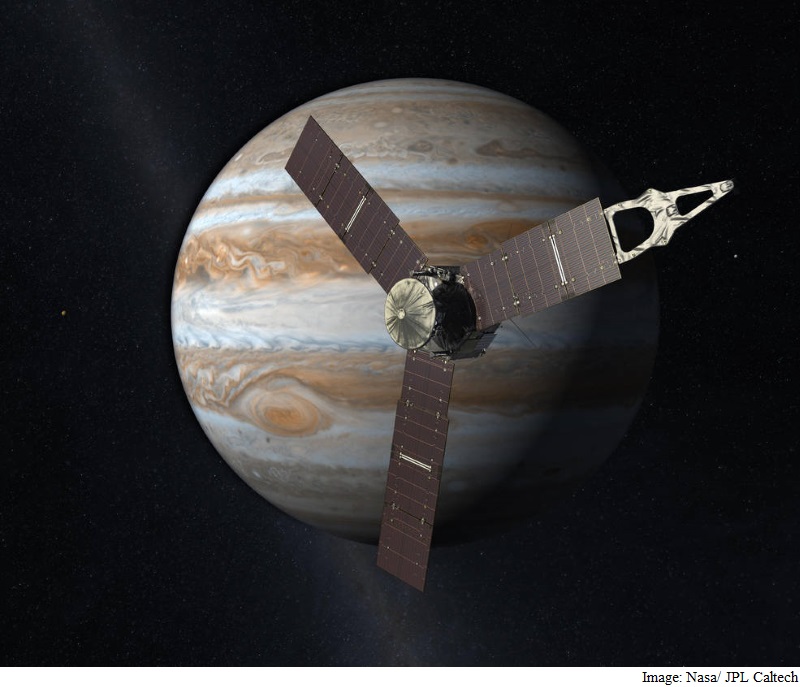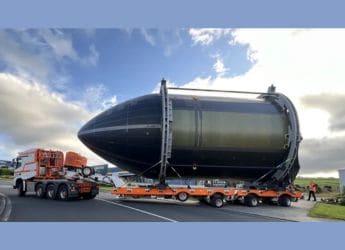- Home
- Science
- Science News
- Nasa's Juno Breaks Distance Record for Solar Powered Spacecraft
Nasa's Juno Breaks Distance Record for Solar-Powered Spacecraft

The probe, launched from the Earth in 2011 to study the giant planet from an elliptical, polar orbit, achieved the milestone on Wednesday when it was about 793 million km from the Sun.
"Juno is all about pushing the edge of technology to help us learn about our origins," said Scott Bolton, Juno principal investigator at the Southwest Research Institute in San Antonio, in a Nasa statement.
The Juno spacecraft will arrive at Jupiter on July 4 this year. It will repeatedly dive between the planet and its intense belts of charged particle radiation, coming only 5,000 km from the cloud tops at closest approach.
"We use every known technique to see through Jupiter's clouds and reveal the secrets Jupiter holds of our solar system's early history. It just seems right that the Sun is helping us learn about the origin of Jupiter and the other planets that orbit it," he explained.
Juno is the first solar-powered spacecraft designed to operate at such a great distance from the Sun.
The four-ton Juno spacecraft carries three 30-foot-long solar arrays festooned with 18,698 individual solar cells.
"Jupiter is five times farther from the Sun than Earth, and the sunlight that reaches that far out packs 25 times less punch," added Rick Nybakken, Juno's project manager from Nasa's Jet Propulsion Laboratory in California.
"While our massive solar arrays will be generating only 500 watts when we are at Jupiter, Juno is very efficiently designed, and it will be more than enough to get the job done," he disclosed.
Solar power is possible on Juno due to improved solar-cell performance and energy-efficient instruments.
The spacecraft is designed in such a way that it can avoid Jupiter's shadow, and a polar orbit that minimises the total radiation.
Over the next year, the spacecraft will orbit the Jovian world 33 times.
During the flybys, Juno will probe beneath the obscuring cloud cover of Jupiter and study Jupiter's aurorae to learn more about the planet's origins, structure, atmosphere and magnetosphere.
The previous record-holder was the European Space Agency's Rosetta spacecraft, whose orbit peaked out at the 792 million km mark in October 2012, during its approach to comet 67P/Churyumov-Gerasimenko.
Prior to Juno, eight spacecraft have navigated the cold, harsh underlit realities of deep space as far out as Jupiter and all have used nuclear power sources to get their job done.
Get your daily dose of tech news, reviews, and insights, in under 80 characters on Gadgets 360 Turbo. Connect with fellow tech lovers on our Forum. Follow us on X, Facebook, WhatsApp, Threads and Google News for instant updates. Catch all the action on our YouTube channel.
Related Stories
- Samsung Galaxy Unpacked 2025
- ChatGPT
- Redmi Note 14 Pro+
- iPhone 16
- Apple Vision Pro
- Oneplus 12
- OnePlus Nord CE 3 Lite 5G
- iPhone 13
- Xiaomi 14 Pro
- Oppo Find N3
- Tecno Spark Go (2023)
- Realme V30
- Best Phones Under 25000
- Samsung Galaxy S24 Series
- Cryptocurrency
- iQoo 12
- Samsung Galaxy S24 Ultra
- Giottus
- Samsung Galaxy Z Flip 5
- Apple 'Scary Fast'
- Housefull 5
- GoPro Hero 12 Black Review
- Invincible Season 2
- JioGlass
- HD Ready TV
- Laptop Under 50000
- Smartwatch Under 10000
- Latest Mobile Phones
- Compare Phones
- Redmi Note 15 5G
- Redmi Note 15 Pro 5G
- Redmi Note 15 Pro+ 5G
- Lava Play Max
- Poco C85 5G
- Honor Magic 8 Lite
- Jolla Phone
- Realme P4x 5G
- Asus ProArt P16
- MacBook Pro 14-inch (M5, 2025)
- OnePlus Pad Go 2
- Poco Pad M1
- Just Corseca Skywatch Pro
- Honor Watch X5
- Acerpure Nitro Z Series 100-inch QLED TV
- Samsung 43 Inch LED Ultra HD (4K) Smart TV (UA43UE81AFULXL)
- Asus ROG Ally
- Nintendo Switch Lite
- Haier 1.6 Ton 5 Star Inverter Split AC (HSU19G-MZAID5BN-INV)
- Haier 1.6 Ton 5 Star Inverter Split AC (HSU19G-MZAIM5BN-INV)
-
 Kepler and TESS Discoveries Help Astronomers Confirm Over 6,000 Exoplanets Orbiting Other Stars
Kepler and TESS Discoveries Help Astronomers Confirm Over 6,000 Exoplanets Orbiting Other Stars
-
 Supernatural Thriller Jatadhara Arrives on OTT: Where to Watch Sonakashi Sinha-Starrer Film Online?
Supernatural Thriller Jatadhara Arrives on OTT: Where to Watch Sonakashi Sinha-Starrer Film Online?
-
 OnePlus 15R Confirmed to Come With 32-Megapixel Selfie Camera, 4K Video Recording Support
OnePlus 15R Confirmed to Come With 32-Megapixel Selfie Camera, 4K Video Recording Support
-
 Rocket Lab Clears Final Tests for New 'Hungry Hippo' Fairing on Neutron Rocket
Rocket Lab Clears Final Tests for New 'Hungry Hippo' Fairing on Neutron Rocket











